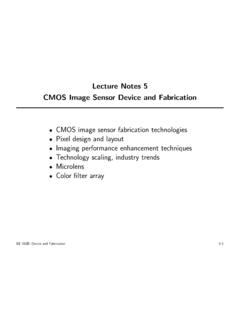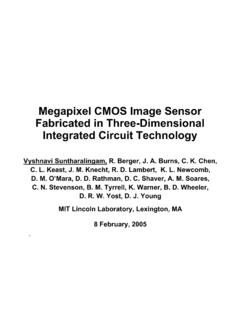Transcription of Trends in CMOS Image Sensor Technology and Design
1 Trends in cmos Image Sensor Technology and DesignAbbas El GamalDepartment of Electrical EngineeringStanford University, Stanford CA 94305 AbstractThree Trends that promise to increase cmos im-age Sensor system performance are presented: (i)modi cations of deep submicron cmos processes toimprove their imaging characteristics, (ii) develop-ments that take advantage of these modi ed deepsubmicron processes, and (iii) high frame rate sensorsand applications to still and video imaging, speci -cally to extending Sensor dynamic range. Recent re-search on Digital Pixel Sensors and applications ofits high frame rate to still and video imaging are Image sensors have received much atten-tion over the last decade, o ering the promise of ul-tra low power and camera-on-chip integration. Re-cently, they have transitioned from research proto-types to high volume production with over 30 mil-lion sensors shipped this year and an estimated an-nual growth rate of over 40% (In-Stat/ MDR Au-gust 2002).
2 Most cmos sensors shipped today areapplication-speci c, , for optical mouse, or usedin low-end applications, , PC-cameras and in older cmos technologies ( m andabove), these sensors generally have large pixels, lowresolutions (VGA and below), and moderate integra-tion. With few exceptions [1], they have lower per-formance than CCDs and as a result are not used indigital cameras. Recent Technology and Design devel-opments in several areas including silicon processing,color lter array and microlens integration, packageminiaturization [2], and pixel and camera-on-chip de-sign, promise to broaden the applicability of cmos Image sensors, and to enhance their performance andfunctionality even beyond that of this paper we discuss three interrelated devel-opments focused on enhancing cmos Image sensorsystem performance: (i) modi cations of deep sub-micron cmos processes to improve their imagingcharacteristics, (ii) developments that will take ad-vantage of the modi ed deep submicron processes,and (iii) high frame rate sensors and applications tostill and video imaging, speci cally to extending sen-sor high dynamic range beyond that of CCDs.
3 Webrie y describe our group's recent work in the latertwo Modi cationsCMOS Image sensors bene t from Technology scal-ing by reducing pixel size, increasing resolution, andintegrating more analog and digital circuits on thesame chip with the Sensor . At 0:25 m and belowhowever, a digital cmos Technology is not directlysuitable for building high quality Image sensors. Theuse of shallow junction and high doping result in lowphotoresponsivity, and the use of shallow trench iso-lation (STI), thin gate oxide, and salicide cause highdark current. Furthermore, in-pixel transistor leak-age becomes a signi cant source of dark current. In-deed in a standard process, dark current due to resettransistor o -current and the follower transistor gateleakage current in an Active Pixel Sensor (APS) [3]pixel can be orders of magnitude higher than thediode leakage itself. As a result of these major prob-lems, process modi cations are papers have reported on several modi- cations to standard cmos technologies to im-prove their imaging performance, , [4].
4 To in-crease photoresponsivity, non-silicided deep junctiondiodes (NW/PSUB or Ndi /PSUB) and integratedmicrolens arrays are used. The doping pro les ofthese diodes are optimized to increase quantum ef- ciency at visiblewavelengths and to lower capaci-tance. Di erent SiON materials are being tried outto increase light transmission. To reduce dark currentnon-silicided, double-di used source/drain implanta-tion is used. Hydrogen annealing was also shown toreduce leakage by passivating defects [4]. The useof pinned photodiodes [1] also signi cantly reducesdark current due to the quenching of surface-interfacetraps by an implanted p-region, while providing morecomplete resets, thereby reducing reset noise and reduce transistor leakage, both the reset and fol-lower transistors in an APS are fabricated with thickgate oxide (70 A). The thresholds of these two transis-tors are also adjusted to further reduce leakage andincrease voltage swing. The reset transistor thresh-old is increased to reduce its o -current, while thefollower transistor threshold is decreased to improvevoltage swing.
5 With these process modi cations, im-age sensors implemented in 0:18 m cmos technol-ogy can achieve high QE and low dark current ofsub-1 nA/cm2[4].Triple-Well PhotodetectorColor imaging today is implemented by depositingphotoresist color lter arrays (CFA) in a mosaic pat-tern on top of the Sensor array. This approach hasseveral shortcomings including reduced spatial reso-lution, color crosstalk, and increased distance fromthe microlens to the photodetector. Foveon's triple-well diode approach [5] promises to increase spatialresolution and reduce spatial color crosstalk of con-ventional CFAs by having each pixel output threecolors. It exploits the dependency of the absorp-tion coe cient onwavelength, whereby longerwave-lengths are absorbed at greater depths. As shownin Figure 1, a triple well photodiode structure withthree separate readout ports is employed. The outputfrom the shallowest junction corresponds to Blue, themiddle junction to Green, and the deepest junctionto Red.
6 Although this approach eliminates the needfor a CFA and demosaicing, thus improving spatialresolution, it has two shortcomings: (i) larger pixelsize than conventional APS (which would mean smallnumber of pixels for the same Sensor area), and (ii)high correlation between the three channels. Figure 2plots the relative color spectral responses for a sen-sor using standard RGB CFA and the Foveon that the overlap between the channels is higherfor the Foveon SubstrateN WellP WellN LddColumnOutBlueColumnOutColumnOutRedGre enRowSelectVnSelectRowVpRowSelectVccVccV ccVnFig. 1. Triple-well TrendsA direct application of the modi ed 0:25 m andbelow cmos technologies is the Design of very highresolution sensors. In [6], it is pointed out thatthe memory-like architecture of cmos Image sen-sors make them better suited for multi-mega pixelresolutions than CCDs, whose readout is the most far reaching advantage of CMOSS ource: TSMCS ource: Dick Lyon, FoveonFig. 2. RGB spectral response for (top) standard CFA and(bottom) Foveon sensors over CCDs is the ability to integrateanalog and digital processing on the same chip withthe Sensor .
7 All cmos Image sensors today includecircuits for signal conditioning, readout, sequencingand clock distribution, some integrate ADC, and afew integrate signal processing circuits for color pro-cessing or for non-imaging applications. As cmos Image Sensor technologies scale it will become possi-ble to integrate all basic camera functions on chip, , [7], to enable applications requiring very smallform-factor and ultra-low power consumption. Inte-gration will also enable the development of more ad-vanced application-speci c devices, , for 3D imag-ing [8] and trend that takes advantage of scaling is in-creasing pixel-level processing by adding more tran-sistors to each pixel. As an example, the Stan-ford Programmable Digital Camera (PDC) group hasbeen exploring Image Sensor architectures with per-pixel ADCs. These architectures, referred to as Dig-ital Pixel Sensor (DPS) [9], o er several advantagesover current analog pixel architectures such as APSincluding, better Technology scaling due to reducedanalog circuit performance demands, the eliminationof column temporal noise and FPN, and high speedreadout.
8 The group has developed three genera-tions of DPS architectures. The most recent [9] isa 352 288 pixel Sensor with per-pixel, 8 bit-parallelsingle-slope ADC operating at a continuous rate of10,000 frames/s (1 Gpixel/s), fabricated in a stan-dard m cmos Technology . Each pixel consistsof an nMOS photogate, a transfer gate, reset tran-sistor, a storage capacitor, a 1-bit comparator, and8 3T memory cells in an area of 9:4 m 9:4 m (seeFigure 3). The photogate subcircuit uses thick oxide( ) transistors (labeled * in the gure) to com-bat the high gate and subthreshold leakage currentsand the low supply voltage problems of the thinoxide transistors.**PGTXP ixel ResetReset VRampBias 1 Bias 2 ReadData I/O8 Comparator8-Bit MemorySensorFig. 3. DPS pixel advantage of cmos scaling, a recent pa-per [10] has investigated using metal patterns de-posited on top of a photodetector in place of CFAs. Itwas demonstrated thatwavelength selectivity can becontrolled by varying the spacing and number of lay-ers of the metal patterns above each pixel's photode-tector.
9 Using 0:13 m or below Technology or multiplepatterned metal layers in 0:18 m, good selectivity inthe visible range can be Frame Rate Sensors and ApplicationsSeveral recent papers have reported on cmos im-age sensors operating at over 500 frames/s, , [11],[9]. In addition to high speed imaging applications,several researchers have recently shown that highframe rate can also bene t still and video rate imag-ing [12], [13]. The idea is to use the high frame rateto oversample the scene thus obtaining more accurateinformation about illumination and motion. This in-formation can then be used to: (i) enhance imagequality, (ii) improve the performance of video appli-cations, or (iii) simplify many low-level vision algo-rithms, , feature important application that the PDC group hasFig. 4. Four of the 500 non-destructively captured images,each with increasing exposure 5. Synthesized high dynamic range investigating is Sensor dynamic range extensionusing multiple capture (see Figure 4).
10 Using the lat-est DPS chip 500 images of a high dynamic rangescene were non-destructively captured at a rate of1400 frames/s. Note that no single Image capturesboth the dark and bright regions of the scene. Thehigh dynamic range Image rendered in Figure 5 wassynthesized from the 500 images by simply using anappropriately scaled version of the last sample beforesaturation for each pixel [14].Although other techniques have been proposed forextending Sensor dynamic range, , well capacityadjusting [15] and time-to-saturation [16], only multi-ple capture has been shown to extend dynamic rangeat the low illumination end. In [14], an algorithm forreducing read noise by weighted averaging of eachpixel's samples before saturation was proposed. Fig-ure 6 illustrates the gain in SNR and DR obtained us-ing this algorithm. We also investigated two other ap-plications of high frame rate, motion blur prevention[14] and accurate optical ow estimation [13]. Suchaccurate optical ow estimates can be used as a basisfor implementing many video applications, includingcompression, motion tracking, super-resolution andmost recently Sensor gain FPN correction [17].












